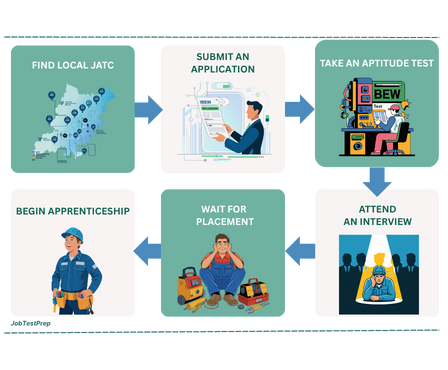Starting a career as an electrician can be exciting, but the path to becoming a licensed professional can also feel confusing — especially when you start hearing about the IBEW test, the NJATC test, and the apprenticeship process.
Many applicants wonder whether these are separate exams or parts of the same system, and who actually runs the training — the union or the school.
In reality, the IBEW (International Brotherhood of Electrical Workers) and the NJATC (National Joint Apprenticeship and Training Committee) work hand in hand to prepare the next generation of electricians.
This article explains the differences between them, how the apprenticeship process works, and everything in between.
Understanding the IBEW and NJATC
Before diving into the testing and application process, it’s important to understand who’s who.
The IBEW: The Union
The International Brotherhood of Electrical Workers (IBEW) is a labor union that represents electrical workers across the United States and Canada.
Its main goal is to protect workers’ rights — negotiating fair wages, benefits, and safe working conditions.
Beyond representing current electricians, the IBEW also helps train new ones by sponsoring apprenticeship programs in partnership with electrical contractors.
The NJATC (Now Electrical Training Alliance): The Training Arm
The National Joint Apprenticeship and Training Committee (NJATC) — now known as the Electrical Training Alliance (ETA) — develops the national training curriculum and testing used in these apprenticeship programs.
It ensures that every apprentice, no matter where they train, receives high-quality, standardized education that prepares them for a lifelong career in the electrical trade.
How the IBEW and NJATC Work Together
The IBEW and the NJATC operate side by side through a partnership called the Joint Apprenticeship and Training Committee (JATC).
Each local JATC is formed jointly by the IBEW, representing workers, and NECA (the National Electrical Contractors Association), representing employers.
Together, they manage everything from recruiting and testing new applicants to placing apprentices with contractors for hands-on training.
The NJATC, now the Electrical Training Alliance, provides the framework — the curriculum, aptitude tests, and national standards — while each local JATC applies those standards within its region.
This partnership ensures that every apprentice receives consistent, top-quality instruction and that contractors gain a workforce trained to the highest professional and safety standards.
The IBEW/NJATC Aptitude Test Explained
The IBEW and the NJATC operate side by side through a partnership called the Joint Apprenticeship and Training Committee (JATC).
Each local JATC is formed jointly by the IBEW, representing workers, and NECA (the National Electrical Contractors Association), representing employers.
Together, they manage everything from recruiting and testing new applicants to placing apprentices with contractors for hands-on training.
The NJATC, now the Electrical Training Alliance, provides the framework — the curriculum, aptitude tests, and national standards — while each local JATC applies those standards within its region.
This partnership ensures that every apprentice receives consistent, top-quality instruction and that contractors gain a workforce trained to the highest professional and safety standards.
The Apprenticeship Application Process
Once you’re ready to begin your journey, the first step is to apply through your local JATC. Each region has its own JATC that works alongside the local IBEW union and NECA chapter. You can easily find yours through the Electrical Training Alliance’s “Find a Training Center” tool online.
Step 1: Submit an Application
Most JATCs require a high school diploma or GED, an official transcript, and proof of algebra proficiency. Applications are usually completed online or in person at the training center.
Step 2: Take the NJATC/IBEW Aptitude Test
After your application is reviewed, you’ll be scheduled to take the IBEW aptitude test. Passing it allows you to move on to the next phase.
Step 3: Interview with the JATC
Successful test takers are invited to a formal interview with a panel of IBEW and NECA representatives. Your combined test and interview scores determine your position on the eligibility list.
Step 4: Begin Apprenticeship Training
When your name reaches the top of the list, you’ll be placed with a NECA contractor, earn wages as an apprentice, and attend classes at your JATC training center.

Why does the Union Oversee the Training?
At first glance, it might seem unusual that a labor union helps manage an education program, but in the IBEW system, it makes perfect sense.
The IBEW’s involvement ensures that apprenticeships are not just training programs — they’re paid career pathways. As an apprentice, you’re both a student and an employee, earning wages while learning.
The IBEW union guarantees fair pay, safe working conditions, and consistent training standards across all regions. Meanwhile, contractors benefit by gaining a highly skilled, dependable workforce.
This shared responsibility keeps the program balanced, fair, and focused on producing top-quality electricians for the industry.
The IBEW and the NJATC may seem like separate entities, but together they form the backbone of one of the most respected apprenticeship systems in the country.
The IBEW represents and protects workers, while the NJATC (now the Electrical Training Alliance) provides the education and structure that shape them into skilled professionals.
By understanding how the union, training centers, and JATCs connect, applicants can confidently navigate the process and take their first steps toward a rewarding electrical career.




